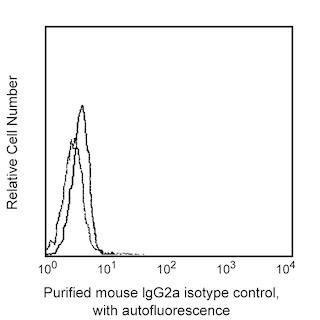Old Browser
This page has been recently translated and is available in French now.
Looks like you're visiting us from {countryName}.
Would you like to stay on the current country site or be switched to your country?




Detection of TLR4 expression on human peripheral monocytes by purified anti-human TLR4 antibody HTA125 (Cat. No. 551964). Human PBMC were stained with 0.5 µg of purified HTA125 using 3-step staining protocol outlined below and anti-human CD14-FITC (Cat. No. 555397) and analyzed with a BD FACScan™ Flow Cytometer (Becton Dickinson, San Jose, CA).


BD Pharmingen™ Purified Mouse Anti-Human Toll-Like Receptor 4

Regulatory Status Legend
Any use of products other than the permitted use without the express written authorization of Becton, Dickinson and Company is strictly prohibited.
Preparation And Storage
Recommended Assay Procedures
A multistep step staining procedure is recommended to amplify immunofluorescent signals for the flow cytometric analysis of human TLR4 expression:
Step 1: Incubate 10^6 cells with 0.25 - 1.0 µg/test of purified HTA125 antibody at 4°C for at least 15 - 20 minutes. Wash cells two times with
staining medium containing sodium azide (e.g., BD Pharmingen™ Stain Buffer, Cat. No. 554656).
Step 2: Incubate the cells with biotinylated anti-mouse Ig (Cat. No. 553999) or biotinylated anti-mouse IgG2a, (Cat. No. 553388) at 4°C for 20
minutes. Wash cells two times.
Step 3: Incubate the cells with ≤0.06 µg of streptavidin-phycoerythrin (Cat. No. 554061) at 4°C for 20 minutes. Wash two times. Resuspend cells
in stain buffer and analyze stained cells by flow cytometry using appropriate specificity and compensation controls.
Product Notices
- Since applications vary, each investigator should titrate the reagent to obtain optimal results.
- Caution: Sodium azide yields highly toxic hydrazoic acid under acidic conditions. Dilute azide compounds in running water before discarding to avoid accumulation of potentially explosive deposits in plumbing.
- An isotype control should be used at the same concentration as the antibody of interest.
- Please refer to www.bdbiosciences.com/us/s/resources for technical protocols.
Companion Products





.png?imwidth=320)
The HTA125 monoclonal antibody specifically binds to the human Toll-like receptor 4 (TLR4), also known as CD284. Toll-like receptors (TLR) are type I transmembrane proteins characterized by an extracellular domain containing leucine-rich repeats and a cytoplasmic domain similar to IL-1R family. In humans, ten TLR have been identified so far. The TLR family acts as a pattern-recognition receptor that is an essential component of pathogen recognition and innate immunity. TLR4 has been identified as the receptor for Gram-negative bacterial lipopolysaccharide (LPS). TLR4 mRNA expression has been found in spleen, placenta, ovary, intestine and lung. Using HTA125, TLR4 protein expression has been detected in monocytes, B cells and T cells in human peripheral blood. The human TLR4 gene has been mapped to chromosome 9q32. The immunogen used to generate the HTA125 hybridoma was human TLR4-transfected Ba/F3 cells. The HTA125 antibody reportedly blocks LPS-triggered, TLR4-mediated stimulation of cells.
Development References (11)
-
Akashi S, Ogata H, Kirikae F, et al. Regulatory roles for CD14 and phosphatidylinositol in the signaling via toll-like receptor 4-MD-2. Biochem Biophys Res Commun. 2000; 268(1):172-177. (Clone-specific). View Reference
-
Akira S. Toll-like receptors and innate immunity. Adv Immunol. 2001; 78:1-56. (Biology). View Reference
-
Beutler B. Tlr4: central component of the sole mammalian LPS sensor. Curr Opin Immunol. 2000; 12(1):20-26. (Biology). View Reference
-
Chuang T, Ulevitch RJ. Identification of hTLR10: a novel human Toll-like receptor preferentially expressed in immune cells. Biochim Biophys Acta. 2001; 1518(1-2):157-161. (Biology). View Reference
-
Chuang TH, Ulevitch RJ. Cloning and characterization of a sub-family of human toll-like receptors: hTLR7, hTLR8 and hTLR9. Eur Cytokine Netw. 2000; 11(3):372-378. (Biology). View Reference
-
Du X, Poltorak A, Wei Y, Beutler B. Three novel mammalian toll-like receptors: gene structure, expression, and evolution. Eur Cytokine Netw. 2000; 11(3):362-371. (Biology). View Reference
-
Paik YH, Schwabe RF, Bataller R, Russo MP, Jobin C, Brenner DA.. Toll-like receptor 4 mediates inflammatory signaling by bacterial lipopolysaccharide in human hepatic stellate cells.. Hepatology. 2003; 37(5):1043-1055. (Clone-specific: Blocking). View Reference
-
Rock FL, Hardiman G, Timans JC, Kastelein RA, Bazan JF. A family of human receptors structurally related to Drosophila Toll. Proc Natl Acad Sci U S A. 1998; 95(2):588-593. (Biology). View Reference
-
Shimazu R, Akashi S, Ogata H, et al. MD-2, a molecule that confers lipopolysaccharide responsiveness on Toll-like receptor 4. J Exp Med. 1999; 189(11):1777-1782. (Immunogen). View Reference
-
Takeuchi O, Kawai T, Sanjo H, et al. TLR6: A novel member of an expanding toll-like receptor family. Gene. 1999; 231(1-2):59-65. (Biology). View Reference
-
Zarember KA, Godowski PJ. Tissue expression of human Toll-like receptors and differential regulation of Toll-like receptor mRNAs in leukocytes in response to microbes, their products, and cytokines. J Immunol. 2002; 168(2):554-561. (Biology). View Reference
Please refer to Support Documents for Quality Certificates
Global - Refer to manufacturer's instructions for use and related User Manuals and Technical data sheets before using this products as described
Comparisons, where applicable, are made against older BD Technology, manual methods or are general performance claims. Comparisons are not made against non-BD technologies, unless otherwise noted.
For Research Use Only. Not for use in diagnostic or therapeutic procedures.